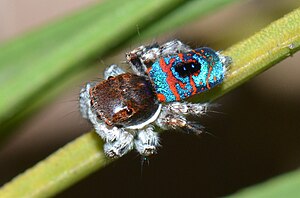Peacock spiders
| Peacock spiders | ||||||||||
|---|---|---|---|---|---|---|---|---|---|---|

Maratus mungaich , male |
||||||||||
| Systematics | ||||||||||
|
||||||||||
| Scientific name | ||||||||||
| Maratus | ||||||||||
| Karsch , 1878 |
The maratus ( Maratus ) are a spider species from the family of the jumping spider (Salticidae) and includes 70 species. (As of December 2016)
Many species originate from Australia . Maratus furvus is common in China .
features
The appearance and behavior of the males is typical of peacock spiders. They have a conspicuously drawn plate on the abdomen (opisthosoma) with often two laterally located wing-like compartments. The plates have a colorful pattern of iridescent colors. They open the side compartments during courtship and raise the abdomen vertically. This is reminiscent of the behavior and appearance of full-grown cocks of peacocks , which fan out their train to impress the females in a similar way. The spiders are therefore called "Peacock Spiders" in Australia, from which the German name is derived.
In the species Maratus vespertilio , lifting the opisthosoma serves not only to attract female attention, but also to encourage the interaction of competing males. For the ability to raise the opisthosoma at almost 90 degrees to its vertical orientation, very long and flexible pedicelles (connecting stalks between opisthosoma and prosoma) had to develop in evolutionary terms.
The taxonomic differentiation of this genus from closely related ones can be made on the basis of the following characteristics: The third pair of legs is the longest and specialized compared to the others. This pair of legs is used to perform courtship movements ("waving"). In the case of related species such as Jotus or Prostheclina , however, it is the first pair of legs that takes on this function and is therefore longer than the remaining pairs of legs. The males of the genus Saitis do not hold up their opisthosoma during courtship. In contrast to the genus Hypoblemum , the peacock spiders have a dorsal colored plate with side fans that can often be opened.
The females are usually not very conspicuously colored and are compactly built. They have a pattern with white to gray or light to dark brown sections. The Epigyne is very simply built and consists of two round openings. Below that are two oval spermatheks . The female as well as the male genital organs (bulbs) differ only slightly between the different species of peacock spider.
The animals are on average 4 to 6 millimeters long. Maratus sarahae is the largest species described so far, with specimens up to 7.5 millimeters long. The females and the males are about the same length per species.
behavior
During courtship, the males dance to the left and right at roughly the same distance from the female and observe the reaction of the possible partner. During the dance, the male stretches his backside up and swings it very quickly to the left and right. The third pair of legs also hold it up and slowly lower it down (waving movement). The lowering takes place in stages and is interrupted with a very rapid vibration of the leg.
Systematics
Some species can be divided into the following groups based on cladistic research. The former genus Lycidas was synonymous with the peacock spiders in 2012 by Jürgen C. Otto and David E. Hill, and 15 species were added. It is not clear whether all species also remain in this genus. 15 other species are not divided into groups. The World Spider Catalog now lists 70 species for the genus.
Calcitrans group
The calcitrans group includes five types:
- Maratus calcitrans Otto & Hill , 2012
- Maratus digitatus Otto & Hill , 2012
- Maratus plumosus Otto & Hill , 2013
- Maratus jactatus Otto & Hill , 2015
- Maratus sceletus Otto & Hill , 2015
Mungaich group
The Mungaich group includes the following six species:
- Maratus avibus Otto & Hill , 2014
- Maratus caeruleus Waldock , 2013
- Maratus karrie Waldock , 2013
- Maratus melindae Waldock , 2013
- Maratus mungaich Waldock , 1995
- Maratus sarahae Waldock , 2013
Pavonis group
The Pavonis group includes three species:
- Maratus pavonis ( Dunn , 1947)
- Maratus splendens ( Rainbow , 1896)
- Maratus watagansi Otto & Hill , 2013
Volans group
In this group, the males have the following in common: They have distinctive yellow stripes on the side compartments. They wear a fringe of white hair around the entire plate of the abdomen. The bristles, the color and the pattern of the leg hair including the third pair of legs are identical. The structure, position and color of the pedipalps also look the same.
The Volans group are of two types:
- Maratus pardus Otto & Hill , 2014
- Maratus volans ( OP-Cambridge , 1874)
Web links
Maratus in the World Spider Catalog
Individual evidence
- ↑ a b c Natural History Museum of the Burgergemeinde Bern: World Spider Catalog Version 17.5 - Maratus . Retrieved December 26, 2016.
- ↑ a b c d Jürgen C. Otto & David E. Hill (2012): Notes on Maratus Karsch 1878 and related jumping spiders from Australia, with five new species (Araneae: Salticidae: Euophryinae). Peckhamia 103.1, pp. 1-81, ISSN 1944-8120 .
- ↑ a b Jürgen C. Otto & David E. Hill (2014): Spiders of the mungaich group from Western Australia (Araneae: Salticidae: Euophryinae: Maratus), with one new species from Cape Arid. Peckhamia 112.1, pp. 1-35, ISSN 1944-8120 .
- ↑ a b c Jürgen C. Otto & David E. Hill (2014): Description of a new peacock spider from Cape Le Grand, Western Australia, with observations on display by males and females and comparative notes on the related Maratus volans (Araneae: Salticidae: Euophryinae: Maratus). Peckhamia 114.1, pp. 1-38, ISSN 2161-8526 .
